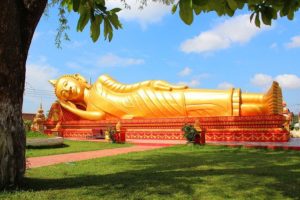The shared history
Thailand and Laos have long been considered as sibling countries, having shared a history even before the colonial era began. They share not only the same origin but the same language – a language that had its largest divergence around the time Laos was being colonized and Chinese immigration to Siam (former name of Thailand) was at its highest point. Laos started incorporating a lot of loan words from French and Vietnamese, while Thai did the same from Southern Chinese dialects, and English to a lesser extent.
The Thai and Lao languages: what do they share in common?
Obviously, Lao and Thai people can understand each other to an extent, but why? Are the similarities that strong?
In terms of vocabulary, about 70 percent of the vocabulary is shared between Lao and Thai. One of the reasons for these similarities is that many words in both languages are taken from Sanskrit and Pali. However, the pronouns, negatives, and wh-question words differ in these two languages. In fact, some words in Lao may be same as in Thai but are used for different purposes.
Grammatically speaking, the grammar of the two languages is mostly identical. They have same comparatives, tenses, cases, and conjugations. As mentioned above, the pronouns are slightly different. As a tiny grammatical difference, Thai generally has more consonants than Lao.
The two languages also have similar alphabets and you’ll find that most of the letters are the same. Their writing style is writing from left to right, with no spaces between words. The Thai writing style is closer to Sanskrit, while Lao was revised to be written phonetically so that even non Lao-ethnic people could read and understand it easily. Many extra consonants are eliminated in Lao and the spelling rules are simplified.
Although the Lao language has been amended and it’s easier for people to pick it up faster, Thai is still the more popular language in the region. The Lao administration distributes newspapers, books, television, and radio programs in Lao throughout the country, and the Lao government forbids the use of Thai language in media and education – though Lao people still show great interest in Thai TV and music.
The way the cultures resemble each other
 In regards to their cultural similarities, both of them appear to be Theravada Buddhist countries and their traditional music and dancing are similar in nature. Their traditional arts and architecture are also very alike, although some experts believe that Thai arts are slightly more delicate. A funny aspect of their cultural lives is that both consider touching older people’s heads as disrespectful, and they both take the matter of food very seriously. It’s a common occurrence in Thailand and Laos for people to put their palms together and do a slight bow – called “wai” – when greeting and thanking each other.
In regards to their cultural similarities, both of them appear to be Theravada Buddhist countries and their traditional music and dancing are similar in nature. Their traditional arts and architecture are also very alike, although some experts believe that Thai arts are slightly more delicate. A funny aspect of their cultural lives is that both consider touching older people’s heads as disrespectful, and they both take the matter of food very seriously. It’s a common occurrence in Thailand and Laos for people to put their palms together and do a slight bow – called “wai” – when greeting and thanking each other.
It seems clear why people from those countries understand each other verbally. But does that mean that they get along and “understand” each other in the other sense of the word?
Their past political conflict
It’s a fact that there has always been a tension between the two countries. The often expressed hostility between Lao and Thai people (though it’s but by no means common or universal) has a number of causes. Firstly, Thailand’s long history of being the major power in the relationship has often lead to resentment in Laos. For a long time, Thailand has been the wealthier and more powerful nation. In the 1820s, due to a Lao uprising against Thai rule, the Thai sacked the capital Vientiane and burned it to the ground. This event is widely remembered and related today by the Lao. In more recent history, during the Cold War Laos became a Communist nation and Thailand was a staunch member of the Capitalist nations faction. There’s been an ongoing border dispute, which flared into a brief war in the 1980s. Neither side won. In modern times, Laos remains a Communist government, bitterly opposed to the influence and power of the Thai monarchy.
However, setting historical events aside, Lao and Thai people generally see and accept each other as friends.
Keeping the above in mind, you definitely need to get acquainted with those two cultures and the magical connection they and their people share – no matter where your starting point is. It’s up to you if it’s going to be visiting the Phi Phi islands or the mesmerizing mount Phousi – but do make sure you take your time getting to know the locals in order to fully immerse yourself in their amazing cultures.

